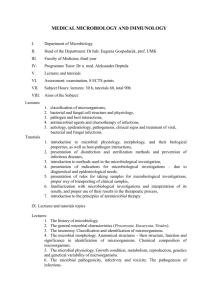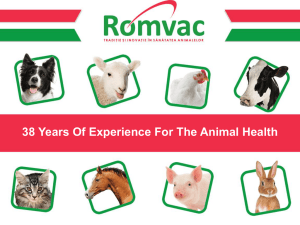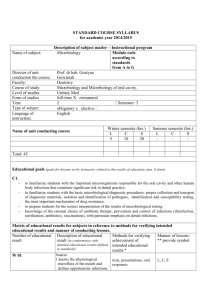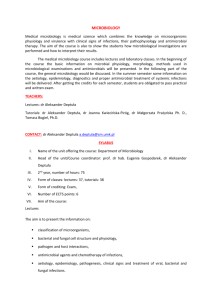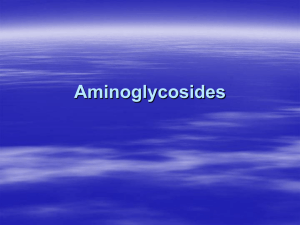Medical Microbiology and Immunology Medical microbiology is
advertisement
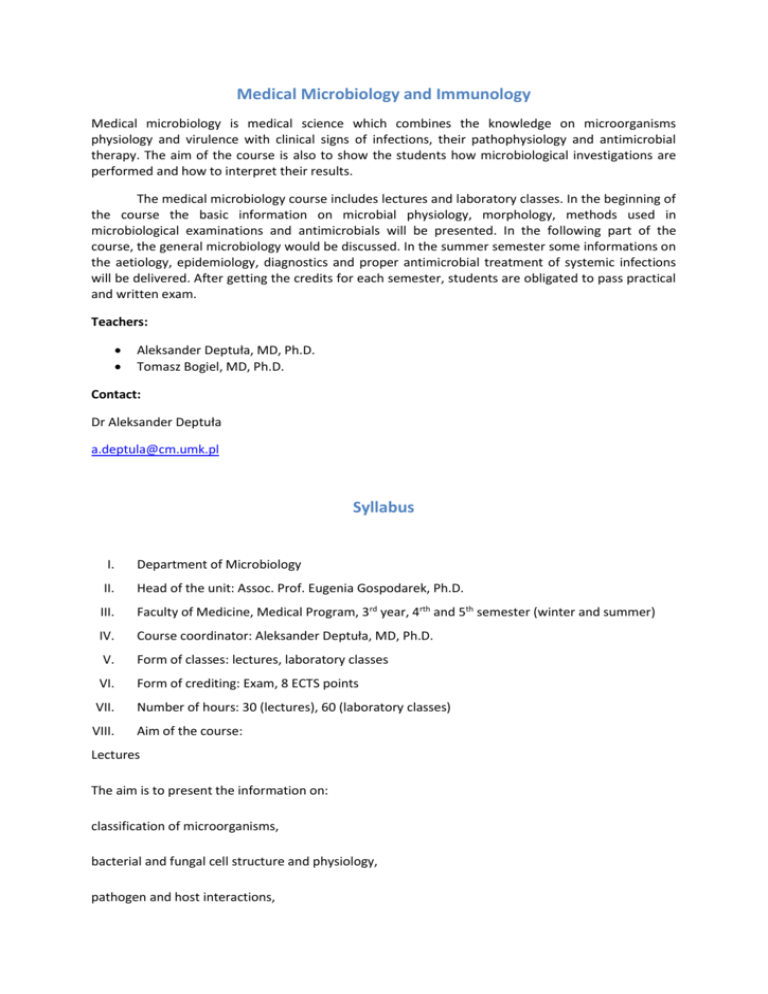
Medical Microbiology and Immunology Medical microbiology is medical science which combines the knowledge on microorganisms physiology and virulence with clinical signs of infections, their pathophysiology and antimicrobial therapy. The aim of the course is also to show the students how microbiological investigations are performed and how to interpret their results. The medical microbiology course includes lectures and laboratory classes. In the beginning of the course the basic information on microbial physiology, morphology, methods used in microbiological examinations and antimicrobials will be presented. In the following part of the course, the general microbiology would be discussed. In the summer semester some informations on the aetiology, epidemiology, diagnostics and proper antimicrobial treatment of systemic infections will be delivered. After getting the credits for each semester, students are obligated to pass practical and written exam. Teachers: Aleksander Deptuła, MD, Ph.D. Tomasz Bogiel, MD, Ph.D. Contact: Dr Aleksander Deptuła a.deptula@cm.umk.pl Syllabus I. Department of Microbiology II. Head of the unit: Assoc. Prof. Eugenia Gospodarek, Ph.D. III. Faculty of Medicine, Medical Program, 3rd year, 4rth and 5th semester (winter and summer) IV. Course coordinator: Aleksander Deptuła, MD, Ph.D. V. Form of classes: lectures, laboratory classes VI. Form of crediting: Exam, 8 ECTS points VII. Number of hours: 30 (lectures), 60 (laboratory classes) VIII. Aim of the course: Lectures The aim is to present the information on: classification of microorganisms, bacterial and fungal cell structure and physiology, pathogen and host interactions, antimicrobial agents and chemotherapy of infections, aetiology, epidemiology, pathogenesis, clinical signs and treatment of viral, bacterial and fungal infections. Laboratory classess introduction to microbial physiology, morphology, and their biological properties, as well as hostpathogen interactions, presentation of disinfection and sterilization methods and prevention of infectious diseases, introduction to methods used in the microbiological investigation, presentation of indications for microbiological investigations – due to diagnostical and epidemiological needs, presentation of rules for taking samples for microbiological investigations, proper way of transporting of clinical samples, familiarization with microbiological investigations and interpretation of its results, and proper use of their results in the therapeutic process, introduction to the principles of antimicrobial therapy. IX. Topics of lectures / tutorials: Lectures: The history of microbiology. The general microbial characteristics (Procaryota, Eucaryota, Virales). The taxonomy. Classification and identification of microorganisms. The microbial morphology. Anatomical structures – their structure, function and significance in identification of microorganisms. Chemical composition of microorganism. The microbial physiology. Growth condition, metabolism, reproduction, genetics and genetical variability of microorganisms. The microbial pathogenicity, infectivity and toxicity. The pathogenesis of infections. The influence of physical factors and chemical substancies on microbial biological properties. Disinfection and sterilization. The overview of disinfectants and antiseptics and their mechanisms of action. The resistance of microorganisms to disinfectants. The antimicrobials – classification, groups overwiev, mechanisms of action. Antimicrobial resistance mechanisms. Methods of antimicrobial resistance testing. The general rules of antimicrobial treatment. The basis of infective immunology. Immunological methods used in microbiological investigations. Immunoprophylaxis and immunotreatment. Vaccines. Immunity sera and immunoglobulines. The bacteriology. Overwiev of bacteria pathogenic for human. The virology. The mycology. Respiratory tract infections. Urinary tract infections. Gastrointestinal tract infections and foodborne diseases. Sexually transmitted diseases. Intra-uterine and neonatal infections. Skin, mucosal and eye infections. Surgical infections. Infections caused by anaerobic bacteria. Central nervous system infections. Bloodstream infections. The microbiological investigation of autopsical samples. The diagnostics of infections. Sampling, storage conditions and transporting of clinical specimens for microbiological investigations. Hospital acquired infections. Infection prevention and control, epidemiological investigation, microorganisms typing methods – the role of microbiologist. Laboratory classes: The organization of classes. Microbiological laboratory safety rules. The Procaryota cell structure. Microscopy techniques. Staining methods and microbial morphology. Methods used for microbiological investigations (part I). Methods used for microbiological investigations (part II). Methods for antimicrobial sensitivity testing. Methods for detection of antimicrobial resistance and interpreting of antimicrobial sensitivity testing results. Test. The characteristic of the Micrococcaceae family. The characteristic of the Streptococcaceae family. Disinfenction and sterilization methods. Visiting the Central Sterilization and DDD department of Dr A. Jurasz University Hospital in Bydgoszcz. The characteristics of: Corynebacterium spp., Listeria spp., Haemophilus spp. The characteristic of sporing bacilli: Bacillus spp. i Clostridium spp. The anaerobes culture methods. Charactersitics of non-sporing anaerobes: Bacteroides spp., Porphyromonas spp.., Prevotella spp., Fusobacterium spp., Peptostreptococcus spp., Peptococcus spp. Test. The microbiological diagnostics of selected spiral bacteria: Helicobacter spp., Campylobacter spp. The characteristics of the Enterobacteriaceae family (part I: Eschrichia spp., Proteus spp., Klebsiella spp., Citrobacter spp., Serratia spp., Enterobacter spp.) The characteristics of the Enterobacteriaceae family (part II: Salmonella spp., Shigella spp., Yersinia spp.) The characteristics of:: Acinetobacter spp., Stenotrophomonas spp., Burkholderia spp., Pseudomonas spp., Neisseria spp., Moraxella spp. Sexually transmitted microorganisms. The characteristcs of acid-fast microorganisms (Mycobacterium spp.). The yeasts – methods for detection and identification. The characteristics of dermatophytes and moulds. Staff and hospital environment microbiological investigation. Disinfectants efficacy testing. Tests. Methods for sampling and transporting clinical samples for microbiological investigation. The human normal flora. The diagnostics of respiratory tract infections. The diagnostics of urinary and gastrointestinal tract infections. The diagnostics of central nervous system infections. The eye infections. The skin infections. The diagnostics of bloodstream infections. The interpretation of microbiological investigation results. X. Self-study topics: ----------- XI. Booklist: Murray PR, Rosenthal KS, Pfaller MA: Medical microbiology. MOSBY Elsevier, 2009 XII. Detailed list of required practical skills and confirmation of completing: Name: Year of study: Group: Academic year: Date Confirmation of Notes completing Recognizing of organs slides on normal human stained with different histological techniques. Rules and regulations Organization of classes 1. The classes are to be held according to the schedule. 2. Students are not to be late for classes. 3. The presence at the classes is mandatory. Two absences during one semester may be the reason of not giving a credit. The absence on laboratory classes does not excuse the student from possessing the knowledge. 4. The students have to come for laboratory classes prepared. 5. The tutor may check if students are prepared for laboratory classes. The form of checking (written or oral) is up to the tutor. 6. Not passing each laboratory classes have to be passed again. Each student can pass each class only twice. Students which won’t have all classes passed will not be able to write test, and it is equivalent with getting an unsatisfactory mark. 7. The students may pass again each test only once. Not passing the first test in the semester until the second test is to be held will not be allowed to write it. Safety instructions 1. Students must not bring with them any coats, umbrellas, bags, hats, etc. for the laboratory classes. 2. Students should avoid any situations which may cause danger: long hairs should be braced, too long nails should be cut and there should be no jewelery on hands etc. 3. During the classes the students must wear lab coats which can be found in the classroom. The coats must be buttoned up. 4. During the classes the students must stay calm, use all the equipment carefully in order not to damage anything and should always listen to the tutor. 5. Each student is responsible for his lab place. 6. The tutor should be informed by the students on every case of damaging anything or injury during the classes. 7. etc.). The students must not take anything with them from the classes (the cultures, slides, coats The terms of crediting classes in case of excused absence 1. Crediting classes in case of excused absence is possible only theoretically, not more than two classes in each semester, the tutor may ask student to perform also some practical skills which were thought during the laboratory classes. Terms and forms of the tests 1. The writing tests are performed according to the schedule. Form and conditions of crediting the subject 1. Students will get a credit on the basis of: presence on the classes, positive mark from the tutor (the average counted from lab classes and tests) and lack of offence against safety instructions. 2. Not getting a credit from laboratory classes requires passing an additional test. Students may take up this test only once. 3. In case of any problems the decision will be made individually by the head of the Department of Microbiology. 4. The credit is given by the head of the unit. Final exam 1. After getting the credit students pass final exam (summer semester). The final exam consists of practical and written part. 2. For the practical exam students must be prepared from all subjects from laboratory classes and know some practical skills required for understanding the principles of microbiological investigations. 3. During the practical exam, students obtain notes, which point value is added to the total points obtained during the theoretical exam. The point values are: 3,0 – 0 pkt. • 3,5 – 0 pts • 4,0 – 1 pts • 4,5 – 2 pts • 5,0 – 3 pts 4. The theoretical part of the final exam is a written test. 5. The final test consists of 60 questions. For each correct answer, students obtain one point. 6. The students must get 36 points (60%) from practical and theoretical part. 7. The marks will be given according to the ranges. 9. Students which achieve the average mark from all laboratory classes and tests at least 4,5 won’t have to pass the final exam. In case of the average at least 4,0 students won’t have to pass the practical exam and will obtain 5 extra points during the final test. 10. Failing the theoretical or practical part of the final exam is equivalent with getting an unsatisfactory note. 11. Failing the theoretical part of the exam requires passing only this part during the repeat exam. 12. The absence during the exam (practical or/and theoretical) is equivalent with obtaining unsatisfactory note, if the student will not deliver the medical certificate during three working days after the exam. In other cases, not mentioned above all regulations are made on the basis of Rules of Studies of the Nicolaus Copernicus University in Torun. The head of the Department of Microbiology Assoc. Prof. Eugenia Gospodarek, Ph.D.

